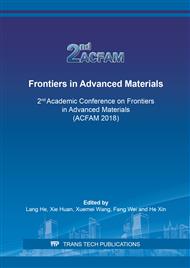[1]
Giuseppe, S Riela, R F Fakhrullin, Clay-based drug-delivery systems: what does the future hold?, J. Ther Deliv. 8(8) (2017) 633-646.
DOI: 10.4155/tde-2017-0041
Google Scholar
[2]
R Ianchis, C Ninciuleanu, I Gifu, E Alexandrescu, R Somoghi, A Gabor, S Preda, C Nistor, S Nitu, C Petcu, Novel Hydrogel-Advanced Modified Clay Nanocomposites as Possible Vehicles for Drug Delivery and Controlled Release, J. Nanomaterials. 7(12) (2017) 443.
DOI: 10.3390/nano7120443
Google Scholar
[3]
M.G. Bekaroğlu, F. Nurili, S. İşçi, Montmorillonite as imaging and drug delivery agent for cancer therapy, J. Appl Clay Sci.162 (2018) 469-477.
DOI: 10.1016/j.clay.2018.06.039
Google Scholar
[4]
S. Jayrajsinh, G. Shankar, Y.K. Agrawal, L. Bakre, Montmorillonite nanoclay as a multifaceted drug-delivery carrier: A review, J. Drug Deliv Sci Tec .39 (2017) 200-209.
DOI: 10.1016/j.jddst.2017.03.023
Google Scholar
[5]
T. Li, L. Zhao, Z. Zheng, M. Zhang, Y. Sun, Q. Tian, S. Zhang, Design and preparation acid-activated montmorillonite sustained-release drug delivery system for dexibuprofen in vitro and in vivo evaluations, J. Appl Clay Sci. 163 (2018) 178-185.
DOI: 10.1016/j.clay.2018.07.026
Google Scholar
[6]
Z.R. Afarani, M.N. Sarvi, M.A. Alavijeh, Modification of montmorillonite nanolayers as a pH-responsive carrier of biomolecules: Delivery of vitamin B12, J. Taiwan Inst Chem E.(2018).
DOI: 10.1016/j.jtice.2018.01.002
Google Scholar
[7]
S Sun, M Li, F Dong, S Wang, L Tian, S Mann, Chemical Signaling and Functional Activation in Colloidosome-Based Protocells, J. Small. 16 (2016) 1920-1927.
DOI: 10.1002/smll.201600243
Google Scholar
[8]
G B B Varadwaj, K Parida, V O Nyamori, Transforming inorganic layered montmorillonite into inorganic-organic hybrid materials for various applications: a brief overview, J. Inorg Chem Front. 3 (9) (2016) 1100-1111.
DOI: 10.1039/c6qi00179c
Google Scholar
[9]
T J Dening, S Rao, N Thomas, C A Prestidge, Montmorillonite-lipid hybrid carriers for ionizable and neutral poorly water-soluble drugs: Formulation, characterization and in vitro lipolysis studies, J. Int J Pharmaceut. 526(1-2) (2017) 95-105.
DOI: 10.1016/j.ijpharm.2017.04.063
Google Scholar
[10]
S Lin, S Sun, K Shen, D Tan, H Zhang, F Dong, X Fu, Photocatalytic microreactors based on nano TiO2-containing clay colloidosomes, J. Appl Clay Sci. 159(2017) 42-49.
DOI: 10.1016/j.clay.2017.08.022
Google Scholar
[11]
J.L. Alves, P.D.T.V.E. Rosa, A.R. Morales, Evaluation of organic modification of montmorillonite with ionic and nonionic surfactants, J. Appl Clay Sci.150 (2017) 23-33.
DOI: 10.1016/j.clay.2017.09.001
Google Scholar
[12]
Y. Xu, M.A. Khan, F. Wang, M. Xia, W. Lei, Novel multi amine-containing Gemini surfactant modified montmorillonite as adsorbents for removal of phenols, J. Appl Clay Sci. 162(2018) 204-213.
DOI: 10.1016/j.clay.2018.06.023
Google Scholar
[13]
Y. Li, A. Wang, Y. Bai, S. Wang, Evaluation of a mixed anionic-nonionic surfactant modified eggshell membrane as an advantageous adsorbent for the solid-phase extraction of Sudan I-IV as model analytes, J. Sep Sci. 40 (2017).
DOI: 10.1002/jssc.201700094
Google Scholar
[14]
S Lal, A Perwez, M A Rizvi, M Datta, Design and development of a biocompatible montmorillonite PLGA nanocomposites to evaluate in vitro oral delivery of insulin, J. Appl Clay Sci. 147(2017) 69-79.
DOI: 10.1016/j.clay.2017.06.031
Google Scholar
[15]
W Shen, H He, J Zhu, P Yuan, R L Frost, Grafting of montmorillonite with different functional silanes via two different reaction systems, J. J Colloid Interf Sci. 313(1) (2007) 268-273.
DOI: 10.1016/j.jcis.2007.04.029
Google Scholar
[16]
L Su, Q Tao, H He, J Zhu, P Yuan, Locking effect: A novel insight in the silylation of montmorillonite surfaces, J. Mater Chem Phys. 136(2–3) (2012) 292-295.
DOI: 10.1016/j.matchemphys.2012.07.010
Google Scholar
[17]
L. Su, T. Qi, H. He, J. Zhu, P. Yuan, R. Zhu, Silylation of montmorillonite surfaces: Dependence on solvent nature, J. J Colloid Interf Sci.Journal of Colloid & Interface Science 391 (2013) 16-20.
DOI: 10.1016/j.jcis.2012.08.077
Google Scholar
[18]
L.F. Polo, R.B. Trinca, M.I. Felisberti, Amphiphilic polyurethane hydrogels as smart carriers for acidic hydrophobic drugs, J. Int J Pharmaceut. 546 (2018).
DOI: 10.1016/j.ijpharm.2018.05.034
Google Scholar
[19]
P T Bertuoli, D Piazza, L C Scienza, A J Zattera, Preparation and characterization of montmorillonite modified with 3-aminopropyltriethoxysilane, J. Appl Clay Sci. 87(2014) 46-51.
DOI: 10.1016/j.clay.2013.11.020
Google Scholar
[20]
N S Alamolhodaei, A M Tsatsakis, M Ramezani, A W Hayes, G Karimi, Resveratrol as MDR reversion molecule in breast cancer: An overview, J. Food Chem Toxicol. 103 (2017) 223-232.
DOI: 10.1016/j.fct.2017.03.024
Google Scholar
[21]
J M Smoliga, O Blanchard, Enhancing the Delivery of Resveratrol in Humans: If Low Bioavailability is the Problem, What is the Solution?, J. Molecules. 19(11) (2014) 17154.
DOI: 10.3390/molecules191117154
Google Scholar
[22]
P.S. Gean, D. Bianca, M.P.C. Lorenzo, C. Dal, L. Daiane, L. Angelo, J. Vladimir, Micronization of trans-resveratrol by supercritical fluid: Dissolution, solubility and in vitro antioxidant activity, J. Ind Crop Prod. 112 (2018) 1-5.
Google Scholar
[23]
Z. Safaeinejad, F. Kazeminasab, A. Kiani-Esfahani, K. Ghaedi, M.H. Nasr-Esfahani, Multi-effects of resveratrol on stem cell characteristics: Effective dose, time, cell culture conditions and cell type-specific responses of stem cells to resveratrol, J. Eur J Med Chem. 155 (2018) 651.
DOI: 10.1016/j.ejmech.2018.06.037
Google Scholar
[24]
B Felice, M P Prabhakaran, A P Rodríguez, S Ramakrishna, Drug delivery vehicles on a nano-engineering perspective, J. Mat Sci Eng C-Mater. 41 (2014) 178-195.
DOI: 10.1016/j.msec.2014.04.049
Google Scholar


